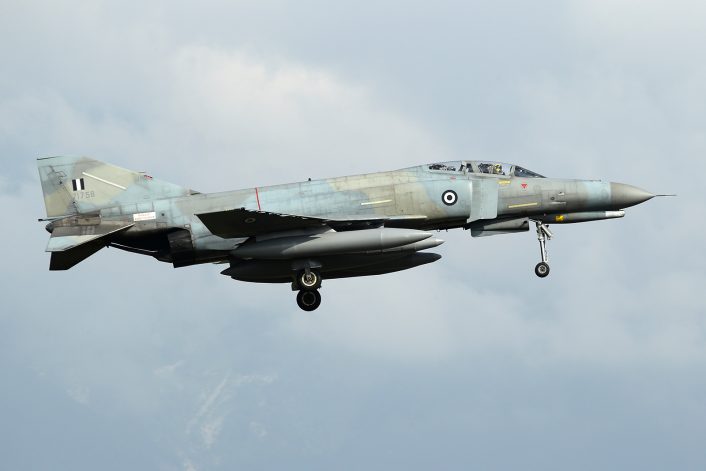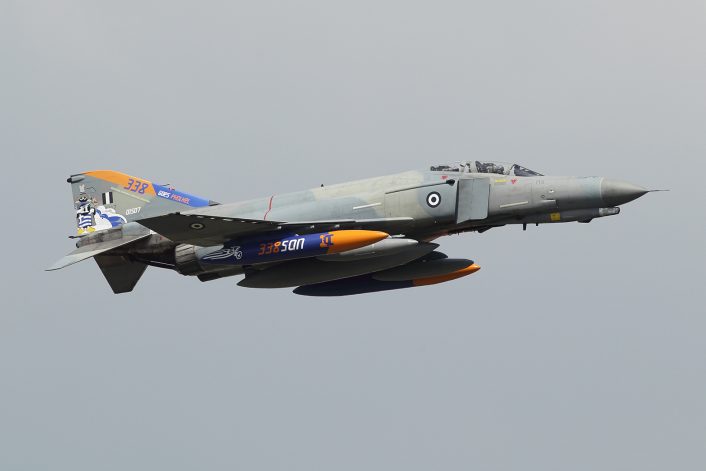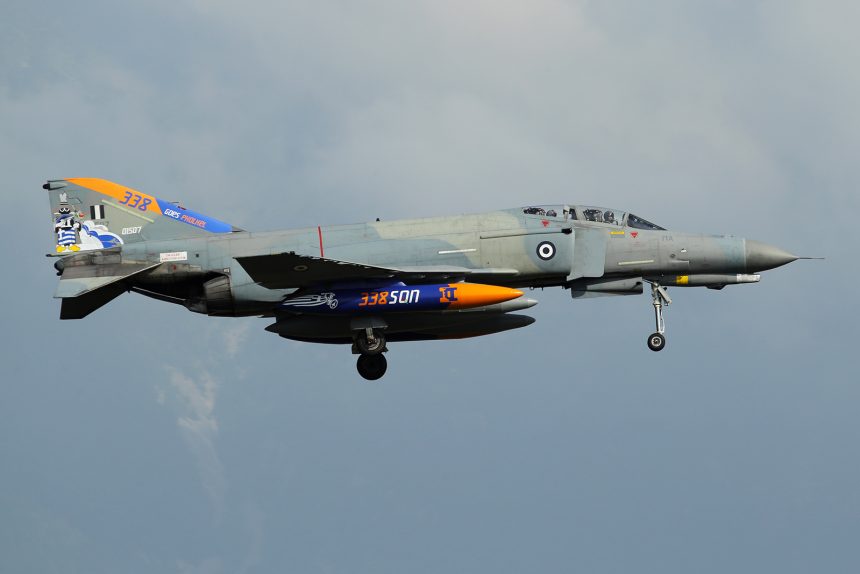Two Hellenic Air Force F-4E “Phantom” jets will take part in the Dutch Air Force Days 2019. One of them, has markings that celebrate the attendance to the airshow in Volkel.
On Jun. 13, 2019, two HAF F-4E AUP jets belonging to the 338 Mira (Squadron), 117 PM (Wing), based at Andravida, Greece, visited Aviano on their way to Volvel Air Base, in the Netherlands. The two Phantoms are in fact taking part in the Dutch Air Force Days 2019 airshow organised by the RNlAF (Royal Netherlands Air Force) this weekend.
Interestingly, one of the aircraft (F-4E AUP 01507 c/n 4465) sported special markings that celebrate the 338 Sqn’s participation in the airshow both on the tail (whose right hand side also sports a “Spooky” with the Greek flag and the text “338 goes Pholkel”) and the external fuel tanks.
The left side of the tail shows Ares (Mars) the Greek God of War, that has been the emblem of the squadron since 1974.
Hellenic Air Force 338 Squadron “Ares” goes RNLAF Volkel Air Base for Luchtmachtdagen 2019.Special scheme designed by @AviationProject.#338GoesPholkel #LMD2019 #Luchtmachtdagen2019 #aviationproject #f4 #phantom #117cw #338sqn #Ares #hellenicairforce pic.twitter.com/9zUlMWbTeP
— Air Force . gr (@wwwairforcegr) June 13, 2019
The history of the Phantom II in the Hellenic Air Force started on Apr. 4, 1974 as the very first Greek F-4E Phantom II landed at Andravida. The Phantoms operated today have been upgraded following a contract, signed in August 1997, with EADS for the Peace Icarus 2000 upgrade, also known as the Avionics Upgrade Program (AUP). The first upgraded aircraft was taken on charge in December 2002.

An interesting description of the upgrades embedded in the AUP program can be found in this Combat Aircraft article.
Here’s an excerpt:
It was decided to upgrade the initial F-4s in Hellenic service (the Peace Icarus I and Peace Icarus II jets) and to apply a Service-Life Extension Program (SLEP) to the entire F-4 and RF-4 fleet. A first AUP-upgraded F-4 was delivered by Hellenic Aerospace Industry in December 2002. In 2005, 337 Mira retired the F-4E SRA jets and replaced these with F-16s, the squadron again assuming its role as lead interception unit in the northern Aegean.
The upgrade efforts were mainly centered around the BVR capability with AIM-120 missiles, reflecting the increased need for CAP jets. The core of the program is the excellent AN/APG-65GY multi-role radar, the CPU-143/A central air data computer, Modular Multi-Role Computer (MMRC), laser gyro inertial navigation system with embedded GPS, AN/APX-113 Advanced Identification Friend or Foe (AIFF), and multi-function color displays.
The avionics package transforms the F-4 from a second-generation fighter with minimal chances of survival in the modern warfare arena into a capable weapon system designed to maximize crew specialization and the allocation of specific duties between front and rear cockpits, increasing the chances of mission success. Compared with before the upgrade, the weapons system officer’s (WSO) role has now been upgraded to match the capabilities of the APG-65 radar that features multiple modes of operation. Furthermore, the use of the Litening pod is the WSO’s sole responsibility. An experienced WSO serves as the ‘brains’ of the tactical formation, providing regular situational awareness updates to other jets, increasing the probability of a kill in air-to-air missions or providing accurate attack parameters for air-to-ground missions. With the Litening pod, F-4s can now undertake non-traditional intelligence, surveillance and reconnaissance (NTISR) duties and launch laser-guided bombs (or designate these weapons for other types)
The photographs of the two F-4E AUP visiting Aviano on Jun. 13 were taken by The Aviationist’s contributor Claudio Tramontin.










